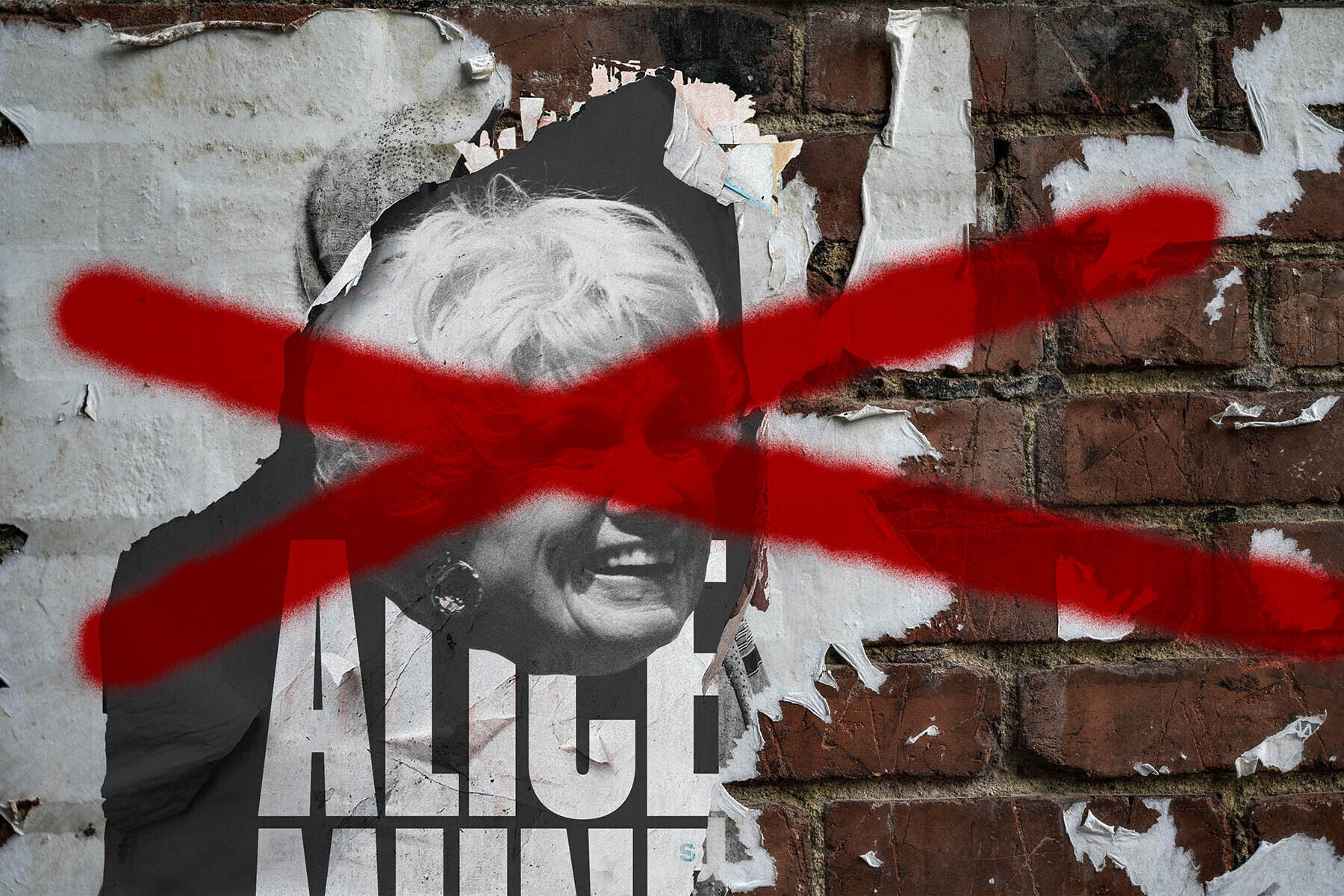This story began as a fairy tale.
I was nineteen, an aspiring writer myself, when I first read the fiction of Alice Munro. Fresh out of an MFA program in my mid-twenties, I moved to Victoria and stumbled upon a job at a bookstore co-founded by my literary idol. For the next nine years, as head of social media at Munro’s Books, I proudly advertised this connection (“Yes, that Alice,” the shop’s website boasted), happy to fill in the blanks of our icon’s elusive public persona with a fantasy of motherly sacrifice—for her bookselling days had coincided with the parenting of her young daughters, a time that predates the current Government Street location. Munro herself never worked in that building, a neoclassical marvel with lofty ceilings and a loftier origin story.
Watching me on the news this past spring, you would never know the link was so distant. In an interview with CBC Vancouver the day after Munro’s death on May 13, I was starry eyed against the deep-blue backdrop of our store banner. Next to it was a copy of My Best Stories, Munro’s aged face peering from the cover with elegant reserve. Soon I’d be taping a poster of the same image to the store’s front window, “1931–2024” typed beneath her name. “Winner of the Nobel Prize in Literature,” it would continue. “Co-founder of Munro’s Books.”
I concluded the interview with a self-professed cliché: Munro had been unflinching.
“She just dared,” I gushed, “to say the things a lot of people wouldn’t.”
Child abuser. Weeks after the interview, a co-worker found those words written in a public guest book for fans of Alice Munro at the store. I was on vacation then, keen to return as moderator for a panel discussion in her memory. Checking my email days before I was due back, I saw a message, entitled “Alice Munro event,” from my employer. It began by confirming my role in the panel. Then it shared some bad news: Andrea Robin Skinner, Munro’s youngest daughter, had been sexually abused by her stepfather, Gerald Fremlin, when she was a child; her mother had learned of the abuse and stayed with him. Citing a post Skinner had written years before, on the blog of a survivors’ organization called the Gatehouse, the email noted that her story was clearly “out there” but unlikely to come up at the event. As I read the words “This wasn’t a secret,” the casual tone suggesting knowledge long dismissed, my faith in a once-sacred allyship started to crumble.
Picture the woman who found the guest book walking to her desk, dazed by the story her employer has just told her. Picture her finding the blog post and reading Skinner’s words: “my mother, Alice Munro.” Picture star-struck customers pouring through the doors as other booksellers read the post and start to emerge from the dream, the memorial event drawing closer by the day.
By the time I read my employer’s email, the event was less than a week away. I responded, noting how risky it could be to keep Skinner’s story secret from the guest authors scheduled to speak on the panel. I wrote that I was not at all sure I could moderate in good conscience. Shortly thereafter, management cancelled the event due to “unforeseen circumstances.” I decided to go on leave. My co-workers remained burdened with the knowledge of our co-founder’s true legacy.
Our problem: the blog post was public—if you knew what you were looking for. At the time, the obvious Google searches brought up biographical notes and think pieces on Munro’s story “Vandals,” a portrait of a pedophile that, we now know, was written in the wake of Skinner’s initial disclosure to her mother in 1992. The post existed in the liminal zone of open secrets, that nebulous space between public and private where my co-workers and I now found ourselves. A group of us who had read her story began exchanging emails.
In the video beneath the blog post, Skinner had described her fear of being called upon for emotional support after so many years of neglect. We fretted that reaching out privately about our discomfort may be read as a plea for exoneration, yet to respond in public would surely invite a media explosion it seemed she had not pursued. My employer had argued that cancelling the event might have prompted questions we had no right to answer. We agreed the story was Skinner’s to tell, not ours. But how could we bear to continue profiting from the secret?
If the dark side of Alice Munro was Skinner’s story to tell, here was ours: A woman-owned business. A Victoria institution. A place where, every evening—as I posted on Instagram—“the sun slants through the stained glass windows, [and] the walls, briefly, glow purple.”
There were other stories that circulated through no effort of our own. Most prominent was the notion that we were a workers’ co-op. In fact, when Munro’s first husband, Jim, retired, at eighty-four, he gave the business to four senior staff, three of whom have since retired themselves. The co-op was a pretty notion, one tied up in the sense that our staff was “like family,” as I often boasted.
I was educated; that was my story. I saw things clearly. Wrote them prettily. And I did love my fellow booksellers—a love tied up in the “creaky floors and roomy aisles, soft light and teeming shelves” that garnered hundreds of likes from strangers scrolling through fairy tales.
We contacted the Gatehouse.
My initial drafts for an email from “concerned staff at Munro’s” were radical. I lambasted Jim and Alice Munro. I brought up changing the store’s name. My co-workers urged me to keep our message gentle, open ended. We weren’t to burden or overwhelm Skinner; that was why we were writing to an intermediary in the first place.
When a co-worker expressed doubt after I had already pressed “Send,” I struggled to rein in my impatience. I knew the hesitation was rooted in kindness. What worse sin could there be for those in our position than to violate a survivor further in the name of solidarity? Yet I could not help but balk at a hands-off approach to suffering—that all-too-Canadian “niceness” that dare not wade into treacherous waters. I thought of a grieving friend from Syria who, in response to claims that friends had just been “giving him space,” shot back: “Your space felt like abandonment.” If the opposite of trauma is connection, surely failing to extend a hand could only leave all of us floundering.
Two days later, a message appeared in our inboxes. “Hello, dear Friends,” Skinner began. “I’m so moved by your email . . .” In words I’ve read so many times since that they serve as a sort of catechism, she shared good news: in just a few weeks, she would publish her story in the Toronto Star, poised, at last, to break the spell of her mother’s celebrity.
Iused to think stories shared themselves. As social media manager, I spent years awaiting the day our store would go viral. I crafted zeitgeisty posts and bit my nails as the likes trickled in; I googled every author we championed, terrified of inadvertently boosting a pariah. In such a volatile landscape, a story as shocking as Skinner’s couldn’t stay buried for long. The fact that it wasn’t already international news seemed like sheer luck—or proof that the Gatehouse website wasn’t search engine optimized.
The more I learn of Skinner’s story, the more I marvel at how naive I was to assume the media would pounce at the slightest whiff of her trauma. When Deborah Dundas, who wrote an accompanying piece for the Toronto Star, gave an interview on The Current, she described how Skinner had tried to share her story for years. No writer who heard it would touch it. From bookstores to biographers to journalists, the literary world had everything to gain from an untarnished Alice Munro. Open secrets require closed doors.
In July, I approached the CBC to offer another interview. I spoke to a male reporter about the culture of silence that had erased Skinner’s truth for decades. I encouraged others within that culture to speak up with me, to hold their employers accountable for choosing profit over compassion. What emerged was a watered-down account, my stony face affixed above a few scant quotes along with the Munro family’s statement of support for the store—a statement given in the wake of our efforts to reach out via the Gatehouse. That context wasn’t provided, the reason for the statement’s existence never probed.
Weeks earlier, another attempt to tell a new story had been thwarted. Reeling from the mismanagement of the event, I’d joined a group of staff in a union drive: a long-held dream at our not-a-co-op bookstore. Twelve signatures later, the lone man on the committee—who never attended a single meeting with our union representative and organizer—sent a staff-wide email claiming we were “clouded by emotion.” He said he would be the first to sign a union card if we organized in “a measured and logical way,” with management’s full awareness.
Reading that email, I thought of Jim Munro, the fatherly figure once at the helm of a majority-female staff. I thought of the legacy he’d left them.
Who holds the power to shape a story? Who holds the power to silence it? When an adult imposes their sexual will on a child, they hijack a lifetime’s worth of self-authorship. Stories, especially those as complex and inescapable as sexuality, are as delicate as they are sacred, easily drowned out by bigger, greedier voices. The ripple effects can be subtle and impossible to predict.
Gerald Fremlin claimed his nine-year-old stepdaughter sought “sexual adventure.” My former employer, it seemed, insisted that her hands were tied; the open secret was a family matter, not hers or the store’s to share. The reporter at the CBC might argue that his job was to tell all sides, no matter that this kind of “balance” so often maintains the lopsided power structures that lead people to go public in the first place.
I step in and out of these stories. I think of #MeToo and the space it granted to open doors long closed. I consider how my employer had asked me to write Munro’s obituary years before the author’s death—years when our co-founder’s legacy should have been top of mind. I remember being tasked with sharing that legacy on the news, how widely and freely my words were spread when they bolstered a lucrative legend.
In July, after almost a decade, I left my job at Munro’s Books. Alice Munro, a fairy-tale figure in a store window, has made way for Andrea Robin Skinner, a woman whose words have touched my life more deeply than her mother’s—for hers are words that invite others to share theirs. Among these are my own mother, who recently told me how she was abused by a teacher in her girlhood: a story whose ripple effects I always sensed but could never name. I tell myself such moments prove, as Skinner wrote to me, that “the truth allows a direction, movement, to happen.” But no one truth alone will guide us. All we have are stories: stories we can shape and share, stories we can sharpen, stories we can use—to borrow Skinner’s words again—to “examine our own lives with an eye to bringing dignity and love into each day, which sometimes flies in the face of what is considered ‘nice.’”
These are our stories to tell.




